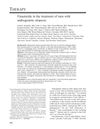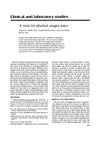TLDR The conclusion is that exogen is a unique hair cycle phase and the new sampling method specifically targets this stage, which may help in future hair loss research.
The study from 17 years ago focused on identifying and characterizing exogen hair, which is the shedding phase of hair, from the human scalp. It involved 23 volunteers and used a non-invasive method involving silicon-based polymers and a calibrated dynamometer to sample exogen hair. The researchers found that exogen hair is passively retained and lacks cellular elements of the outer root sheaths, unlike telogen hair. The method developed did not affect other hair cycle stages and typically found less than seven exogen hairs per cm² in normal individuals. Additionally, the study showed that exogen hair is thinner and can be exhausted with repeated sampling, with the first sampling accounting for over half of the total exogen hair. One male subject with a high number of exogen hairs suggested an early stage of androgenetic alopecia. The study concluded that exogen is a distinct phase of the hair cycle and the sampling method is specific for this stage, which could be useful in future hair loss research.
44 citations
,
August 2004 in “Journal of Investigative Dermatology”  30 citations
,
May 2004 in “Journal der Deutschen Dermatologischen Gesellschaft”
30 citations
,
May 2004 in “Journal der Deutschen Dermatologischen Gesellschaft” The document concludes that early diagnosis and treatment are crucial for children with hair loss to prevent permanent damage, although not all conditions can be effectively treated.
50 citations
,
February 2004 in “Genomics” A gene mutation causes lanceolate hair in rats by disrupting hair shaft integrity.
 129 citations
,
October 2000 in “British Journal of Dermatology”
129 citations
,
October 2000 in “British Journal of Dermatology” Finasteride helps increase hair growth in men with hair loss.
 581 citations
,
October 1998 in “Journal of The American Academy of Dermatology”
581 citations
,
October 1998 in “Journal of The American Academy of Dermatology” Finasteride safely and effectively treats male pattern hair loss, but may cause reversible sexual issues and harm male fetuses.
 17 citations
,
August 1979 in “Journal of The American Academy of Dermatology”
17 citations
,
August 1979 in “Journal of The American Academy of Dermatology” A new staining method helps tell growing from resting hairs to diagnose hair loss.
95 citations
,
July 2006 in “British Journal of Dermatology” Vitamin D receptors in hair follicles change with the hair cycle, affecting hair growth.
45 citations
,
April 2001 in “The journal of investigative dermatology/Journal of investigative dermatology” Different Myc family proteins are located in various parts of the hair follicle and may affect stem cell behavior.
10 citations
,
October 2000 in “PubMed” E6/E7 oncogenes in hair follicles cause continuous hair growth by skipping the resting phase.
69 citations
,
May 1997 in “Veterinary Pathology” The angora mouse mutation causes long hair and hair defects due to a gene deletion.




